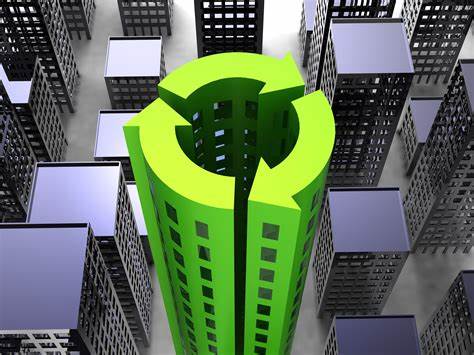
Sustainable Materials for Smart Buildings: The Key to a Greener Future
Introduction
Sustainable materials are essential for the development of smart buildings, which aim to be energy-efficient, environmentally friendly, and technologically advanced. As the world faces the challenges of climate change and resource depletion, the importance of incorporating sustainable materials in building construction becomes increasingly evident. This article explores the historical background, key concepts, benefits, implementation considerations, case studies, current trends, challenges, and future outlook of sustainable materials in smart buildings.
Historical Background
The use of sustainable building materials has evolved over time as a response to the need for more environmentally responsible construction practices. In the past, traditional materials like wood, stone, and clay were widely used. However, the industrial revolution brought about a shift towards the use of more synthetic and resource-intensive materials. It was not until the late 20th century that the concept of sustainability gained traction, leading to the development of green building practices and the use of sustainable materials.
Key Concepts and Definitions
Sustainable materials are those that are responsibly sourced, have minimal environmental impact throughout their life cycle, and promote resource conservation. They possess characteristics such as durability, energy efficiency, recyclability, and non-toxicity. On the other hand, smart buildings are designed to optimize energy consumption, enhance occupant comfort and productivity, and reduce environmental impact by utilizing advanced technologies, automation, and data-driven systems. The integration of sustainable materials in smart buildings ensures that the environmental benefits of smart technology are maximized.
Main Discussion Points
Benefits of Sustainable Materials in Smart Buildings
One of the key benefits of sustainable materials in smart buildings is their contribution to energy efficiency. By using materials with excellent thermal insulation properties, such as natural fibers and high-performance composites, smart buildings can reduce heating and cooling loads, thereby lowering energy consumption. Additionally, sustainable materials help reduce the environmental impact of buildings by minimizing greenhouse gas emissions, conserving natural resources, and improving indoor air quality. Moreover, the use of sustainable materials often leads to cost savings and economic benefits for building owners and occupants.
Types of Sustainable Materials for Smart Buildings
Various types of sustainable materials can be incorporated into smart buildings. Recycled and reclaimed materials, such as recycled concrete, reclaimed wood, and recycled steel, offer a sustainable alternative to virgin materials. Low-impact materials, such as bamboo, straw, and natural fibers, have a smaller carbon footprint compared to traditional materials. Renewable materials, including wood, cork, and bio-based polymers, are sourced from rapidly replenishing resources. Smart materials and technologies, such as phase-change materials and self-healing concrete, can enhance the performance and functionality of smart buildings.
Implementation and Considerations
The successful implementation of sustainable materials in smart buildings requires careful consideration during the design and construction phase. Architects and engineers must account for factors such as material selection, durability, and recyclability, while ensuring compatibility with smart technologies. Life-cycle analysis and assessment are essential tools for evaluating the environmental impact of materials throughout their entire life cycle, from extraction to disposal. Furthermore, certification and rating systems, such as LEED (Leadership in Energy and Environmental Design), provide guidelines and benchmarks for sustainable building practices.
Case Studies or Examples
Several case studies exemplify the successful integration of sustainable materials in smart buildings. LEED Platinum-certified buildings, such as the Bullitt Center in Seattle and the Bank of America Tower in New York City, showcase the use of sustainable materials and advanced technologies to achieve high-performance, energy-efficient structures. Additionally, the retrofitting of existing buildings with sustainable materials has become a popular trend, with examples such as the Empire State Building in New York City, which achieved significant energy savings through the use of sustainable materials and smart technologies.
Current Trends or Developments
Advancements in renewable and low-impact materials are shaping the future of sustainable building practices. Innovations in bio-based materials, such as mycelium-based composites, offer sustainable alternatives to traditional materials. Furthermore, the integration of the Internet of Things (IoT) in smart buildings enables real-time monitoring and control of energy consumption, optimizing resource efficiency. Ongoing research on smart materials and their applications, such as transparent solar panels and self-cleaning coatings, holds promise for further advancements in the sustainable materials industry.
Challenges or Controversies
While the benefits of sustainable materials in smart buildings are undeniable, challenges and controversies persist. Cost implications often deter builders and developers from adopting sustainable materials, as they can be more expensive upfront. However, it is important to consider the long-term cost savings and environmental benefits that sustainable materials offer. Compatibility and interoperability challenges arise when integrating various smart technologies and systems in buildings, requiring careful coordination and planning. Balancing aesthetics and sustainability in building design remains a challenge, as some sustainable materials may have limitations in terms of their visual appeal.
Future Outlook
The potential for widespread adoption of sustainable materials in smart buildings is promising. As awareness of environmental issues grows and building codes become more stringent, the demand for sustainable materials will increase. Advancements in smart materials, such as self-healing concrete and energy-generating facades, will revolutionize building design and performance. Emerging technologies, such as 3D printing and nanotechnology, will further influence the sustainable materials industry, paving the way for innovative and eco-friendly solutions.
Conclusion
In conclusion, sustainable materials are vital components of smart buildings, offering numerous benefits in terms of energy efficiency, environmental impact, and economic savings. With the integration of sustainable materials, smart buildings can achieve optimal performance, occupant comfort, and environmental responsibility. Embracing sustainable materials in building design and construction is not only a necessity but also a pathway towards a greener and more sustainable future.
References
Smith, J. (2019). Sustainable Materials for Smart Buildings. New York: Routledge.
Green Building Certification Programs. Retrieved from www.usgbc.org
Research Papers and Industry Reports. Retrieved from www.researchgate.net